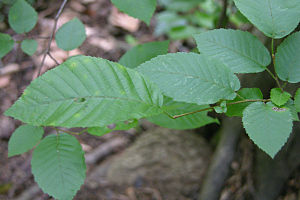American hornbeam
| American hornbeam | ||||||||||||
|---|---|---|---|---|---|---|---|---|---|---|---|---|

Carpinus caroliniana (leaves) |
||||||||||||
| Systematics | ||||||||||||
|
||||||||||||
| Scientific name | ||||||||||||
| Carpinus caroliniana | ||||||||||||
| Walter |
The Carpinus caroliniana ( Carpinus caroliniana ) is a deciduous tree -type in the genus of hornbeam ( Carpinus ) from the family of the birch family (Betulaceae).
description
The American hornbeam is a deciduous tree that reaches heights of up to 12 meters, with a strongly rounded, almost spherical crown . The bark is smooth and blue-gray in color. The elliptical leaves are 5 to 10 cm long and 3 to 5 cm wide; they are double serrated and yellow-green on the underside.
The American hornbeam is single-sexed ( monoecious ). The flowers stand together in pendulous catkins . The male flowers have no bracts and their catkins are 2 to 6 cm long. The female flowers stand together in catkins 2.5 to 12 cm long. The female flowers have inconspicuous bracts and two thread-like, red stigmas. Each female flower is surrounded by a three-lobed envelope, which is formed from the bract and both bracts and is 2 to 3.5 × 1.4 to 2.8 cm in size.
Lonely nut fruits are formed.
Occurrence
The American hornbeam is native to almost the entire eastern third of North America , more precisely from Québec and New England to Minnesota in the north to south in Texas and Florida . As locations it prefers heavy, moist soils on rivers and in swamps.
Subspecies
There are two subspecies. They form hybrids in the overlapping areas of their areas:
- Carpinus caroliniana Walt. subsp. caroliniana : Its range extends from the Atlantic coastal plains to the north to Delaware and from the west from the lower Mississippi Valley to Texas in the east.
- Carpinus caroliniana subsp. virginiana (Marshall) Furlow : Your area extends from Canada in the north and the Appalachians to the west to Minnesota and to the south to Arkansas . Their leaves are larger and have dark glands.
literature
- John J. Furlow: Betulaceae in Flora of North America, Volume 3: Carpinus caroliniana - Online. (engl.)
Individual evidence
- ^ A b Rafaël Govaerts (Ed.): Carpinus - World Checklist of Selected Plant Families of the Royal Botanic Gardens, Kew. Last accessed on January 11, 2017.